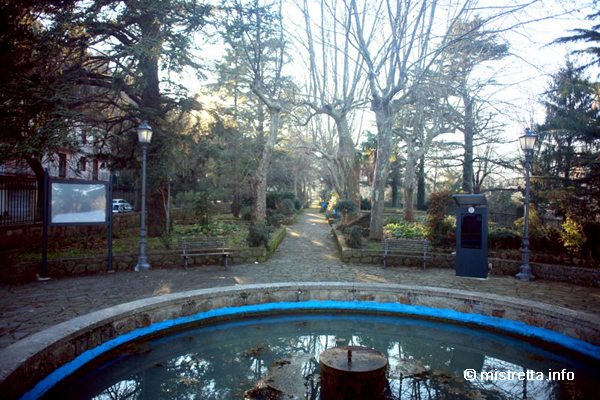
Villa Chalêt
L’appetibilità edilizia del quartiere Saddio e del Calvario segnava un’accelerazione col passaggio dello stradone carrabile che dalla marina giungeva a Mistretta proprio da questa parte, traversando la contrada Cicè (post 1834). Maturava così l’idea di attrezzare uno spazio verde sia per la cittadinanza, sia per i forestieri che giungevano in città. Il 20 marzo 1878 veniva avanzata in Consiglio comunale la prima proposta per la realizzazione di un "pubblico passeggio" al cosiddetto Calvario, fatto che sembrava concretizzarsi con la confisca dei beni del Convento (1866), sebbene, ancora nel 1881 si deliberasse l'acquisto di un terreno da privati, utile alla definizione dell'opera. Alla fine del XIX secolo, quindi, si mettevano in atto le sistemazioni idrauliche, i drenaggi e la piantumazione di due lunghi filari di platani che, nel giro di qualche decennio, si sviluppavano creando una galleria ombrosa e parallela al contiguo stradone. La promenade veniva a configurarsi come villa, con siepi, muretti e ringhiere, solo con i progetti dell’ing. Lucio Lorello, tecnico comunale, (1905) e dell’ing. Francesco Liuzzo (1907). Entrambi, dopo la delimitazione perimetrale, finivano per configurare un giardino geometrico organizzato longitudinalmente sul preesistente viale dei platani. Una grande vasca circolare veniva dislocata in corrispondenza dell’accesso principale, riutilizzando le pezzature provenienti da quella rimossa in piazza Vittorio Veneto, per fare posto al Monumento dei Caduti (1934). Odiernamente il giardino ospita anche numerose sculture contemporanee frutto dei simposi estemporanei svolti negli ultimi decenni.

Villa Chalêt
The Saddio district and the Calvary became attractive building areas with the passage of the road that from the coast reached Mistretta just from this side, crossing the Cicè locality (after 1834). Thus, it was felt the need to equip a green area for both inhabitants and foreigners coming to town. On March 20, 1878, the first proposal to create a “public promenade” at the so-called Calvary was put forward during the town council, event that seemed to materialize with the confiscation of property of the convent (1866), although again in 1881 it was approved the purchase of a land by private owners, useful to the definition of the work. At the end of the XIX century, they were implemented hydraulic arrangements, drainages, and the planting of two long rows of plane trees that, in a few decades, grew up to create a shady gallery parallel to the adjoining driveway. The promenade came to assume the form of a villa, with edges, walls and railings, only with the project of the engineer Lucio Lorello, municipal technician, and engineer Francesco Liuzzo (1907). Both the engineers, after the perimeter delimitation, configured a geometric garden organized longitudinally on the existent avenue of the plane trees. A large round basin was located at the main entrance, reusing pieces removed from the one in piazza Vittorio Veneto to make room for the Monument to the Fallen (1934). The garden now hosts many contemporary sculptures, outcome of extemporaneous symposia held in the past decades.
